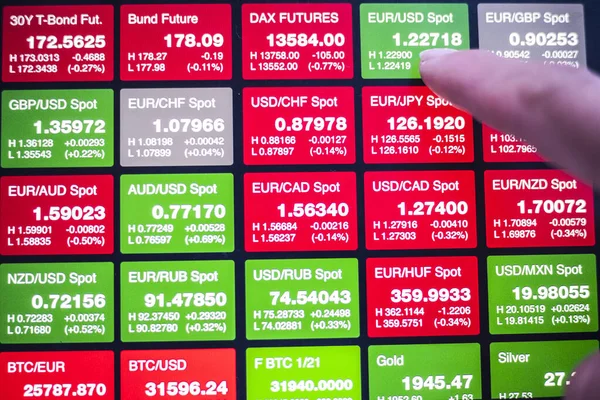Comparing Different Forex Signal Providers: What to Look For

As Forex trading becomes increasingly popular among Iranian traders, the demand for reliable Forex signal providers has also grown. Forex signals offer traders timely alerts on potential trading opportunities, helping them make more informed decisions. However, not all signal providers are the same, and choosing the right one can make a significant difference in your trading success. In this article, we will explore what to look for when comparing different Forex signal providers, highlighting the key features, reliability factors, and how they can impact your trading strategy.
What Are Forex Signals?
Forex signals are trade recommendations that indicate the best time to buy or sell a currency pair. These signals are usually based on technical analysis, fundamental analysis, or a combination of both. Signal providers send these alerts to traders via various channels such as email, SMS, apps, or social media, enabling them to take action based on the recommendations.
Types of Forex Signals:
- Manual Signals: Generated by human analysts based on market research and expertise.
- Automated Signals: Generated by trading algorithms or robots that analyze the market using predefined strategies.
Key Features to Look for in a Forex Signal Provider
When comparing different Forex signal providers, there are several critical factors you should consider to ensure you choose a service that aligns with your trading style and goals.
1. Accuracy and Reliability
The most important factor to consider is the accuracy of the signals. Look for providers that have a proven track record of accurate signals with a high success rate. Many providers will publish their performance history, allowing you to evaluate their past success.
2. Transparency
Transparency is vital when choosing a signal provider. Reputable providers will clearly outline their trading strategies, success rates, and the risks involved. Avoid providers who make unrealistic promises of guaranteed profits.
3. Signal Delivery Methods
Different signal providers offer various delivery methods. Some send signals via email, SMS, or dedicated apps, while others might use Telegram or other messaging platforms. Ensure the delivery method suits your preferences and offers real-time updates.
4. Signal Frequency
Signal frequency refers to how often the provider sends trading signals. Some traders prefer frequent signals, while others may prefer fewer, high-quality signals. Make sure to choose a provider whose signal frequency matches your trading style and time availability.
5. Risk Management
Good Forex signal providers often include risk management instructions such as recommended stop-loss levels and take-profit targets. This ensures that traders can minimize risk and protect their capital when using the signals.
6. Free vs. Paid Signals
Some signal providers offer free signals, while others charge a subscription fee. Free signals can be a good starting point for beginners, but paid services often provide more reliable and in-depth analysis. Consider your budget and trading goals when choosing between free and paid signals.
Comparing Forex Signal Providers
| Feature | Manual Signals | Automated Signals | Free Signal Providers | Paid Signal Providers |
|---|---|---|---|---|
| Who Generates | Human analysts based on market analysis | Trading algorithms or robots | Usually offer limited signals for free | Charge a fee for premium, detailed signals |
| Accuracy | Can vary based on the expertise of the analyst | Consistent but dependent on algorithms | Lower accuracy and fewer features | Generally more accurate with better analysis |
| Cost | Often more expensive due to human input | Often cheaper due to automation | Free of charge, good for beginners | Subscription-based, more in-depth insights |
| Signal Delivery | Email, SMS, apps, social media | Apps, automated trading platforms | Telegram, email, apps | Email, SMS, app notifications |
| Risk Management | Often includes stop-loss and take-profit suggestions | May include risk management settings | Limited or no risk management guidelines | Offers comprehensive risk management advice |
How to Evaluate a Forex Signal Provider
Choosing the right Forex signal provider involves a combination of research, testing, and careful evaluation. Here are the steps to follow:
1. Research the Provider
Start by researching multiple providers. Look for reviews, customer testimonials, and their performance history. Pay attention to the accuracy of their past signals and whether they have a transparent system.
2. Test with a Demo Account
Once you’ve identified a potential provider, consider testing their signals on a demo trading account. This will allow you to evaluate the provider’s accuracy and suitability for your trading style without risking real money.
3. Check Compatibility with Your Broker
Ensure that the signal provider is compatible with your Forex broker and trading platform. Some providers may work better with certain brokers or require specific software to integrate with your account.
4. Monitor Performance Regularly
Even after choosing a signal provider, it’s essential to monitor their performance regularly. Markets change, and signal providers may experience periods of lower accuracy. Continuously evaluate whether the provider meets your expectations.
Tips for Iranian Traders
Given the unique economic and regulatory landscape in Iran, traders should consider signal providers that offer specific features suited to their needs:
- Regulated Brokers: Ensure that your signal provider works with regulated brokers who offer services in Iran.
- Risk Management: With the fluctuating value of the Iranian Rial, it's important to work with signal providers who prioritize risk management.
- Local Support: Look for signal providers that offer customer support in Farsi or understand the nuances of trading in Iran.
FAQ
1. What is a Forex signal?
A Forex signal is a recommendation provided by experts or algorithms that suggests when to buy or sell a currency pair in the Forex market.
2. How can I find a reliable Forex signal provider?
Look for providers with a proven track record, transparent performance history, risk management tools, and clear communication methods such as SMS or email alerts.
3. Are free Forex signals reliable?
Free Forex signals can be useful for beginners, but they may not be as accurate or detailed as paid services. Paid providers often offer more comprehensive analysis and better accuracy.
4. What is the difference between manual and automated signals?
Manual signals are generated by human analysts based on market analysis, while automated signals are created by trading algorithms or robots based on predefined rules.
5. How often should I expect to receive Forex signals?
The frequency of Forex signals depends on the provider. Some offer multiple signals per day, while others may provide only a few high-quality signals per week.
6. Do Forex signals include risk management instructions?
Many reliable Forex signal providers include risk management guidelines, such as stop-loss and take-profit levels, to help traders minimize risk.
7. What platforms can Forex signals be delivered on?
Forex signals can be delivered through various platforms, including email, SMS, mobile apps, and even messaging apps like Telegram.
8. How much do paid Forex signal services cost?
The cost of paid Forex signal services varies widely, but they typically range from $30 to $200 per month, depending on the provider and the level of service offered.
9. Can I use Forex signals on a demo account?
Yes, you can test Forex signals on a demo account to evaluate their accuracy and suitability for your trading style without risking real money.
10. How do I know if a signal provider is legitimate?
A legitimate signal provider will have transparent performance records, positive reviews, and offer clear, realistic expectations rather than promising guaranteed profits.
Choosing the right Forex signal provider can significantly improve your trading strategy and outcomes. By considering key factors such as accuracy, risk management, and signal delivery methods, you can find a provider that suits your trading style and helps you navigate the complexities of the Forex market. For Iranian traders, it’s essential to find a signal provider that understands the local economic conditions and can offer the right support.


